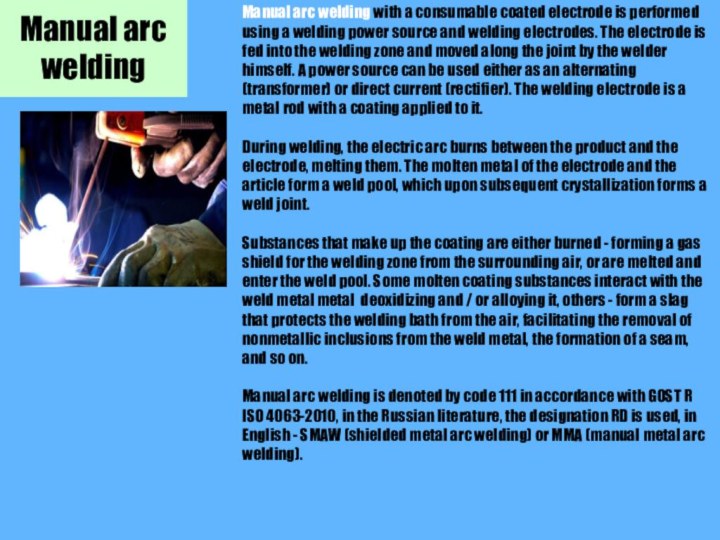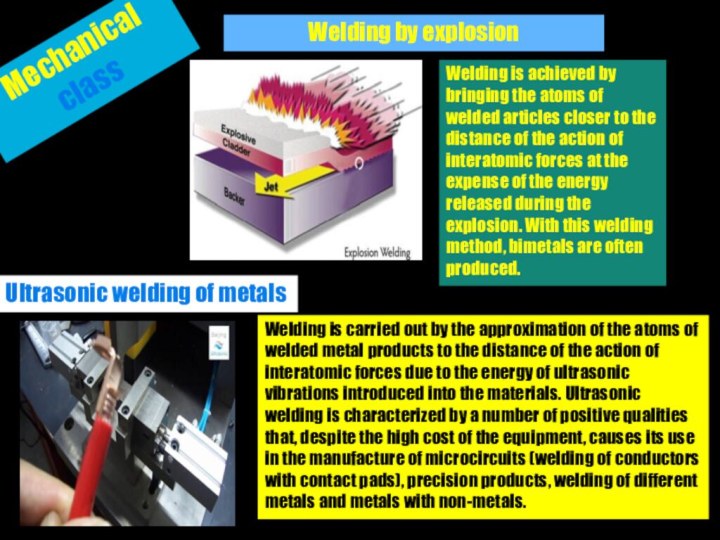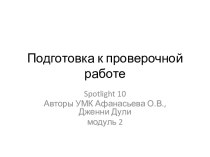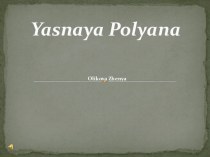- Главная
- Разное
- Бизнес и предпринимательство
- Образование
- Развлечения
- Государство
- Спорт
- Графика
- Культурология
- Еда и кулинария
- Лингвистика
- Религиоведение
- Черчение
- Физкультура
- ИЗО
- Психология
- Социология
- Английский язык
- Астрономия
- Алгебра
- Биология
- География
- Геометрия
- Детские презентации
- Информатика
- История
- Литература
- Маркетинг
- Математика
- Медицина
- Менеджмент
- Музыка
- МХК
- Немецкий язык
- ОБЖ
- Обществознание
- Окружающий мир
- Педагогика
- Русский язык
- Технология
- Физика
- Философия
- Химия
- Шаблоны, картинки для презентаций
- Экология
- Экономика
- Юриспруденция
Что такое findslide.org?
FindSlide.org - это сайт презентаций, докладов, шаблонов в формате PowerPoint.
Обратная связь
Email: Нажмите что бы посмотреть
Презентация на тему по английскому языку на тему Сварка
Содержание
- 2. 1.Basic concepts2.History3.Classification of metal welding4.Thermal class5.Thermomechanical class 7.International designations of welding methods8.Welding in artСontent6.Mechanical class9.The conclusion.
- 3. Objectives:1) Monitoring the information on the theme
- 4. Welding Welding is the process of
- 8. Thermal classWelding arcThe electric arc used for
- 9. Over the length of the arc gap,
- 10. Arc weldingThe source of heat is an
- 11. Manual arc weldingManual arc welding with a
- 12. Non-consumable electrode weldingWelding by non-consumable electrode, in
- 13. Mechanized welding with a consumable electrode in
- 14. In English-language foreign literature is referred to
- 15. Orbital welding - a kind of welding
- 16. The source of heat is a gas
- 17. In most cases, termite welding refers to
- 18. Electron beam weldingThe source of heat is
- 19. Laser weldingThe source of heat is a
- 20. Butt welding of plastic by reflowThe source
- 21. Thermomechanical classForging weldingThe first in the history
- 22. Spot WeldingWhen spot welding, the parts are
- 23. Butt welding resistanceThe workpieces installed and fixed
- 24. Butt welding with continuous reflowIt consists of
- 25. Relief weldingThe details for welding are pre-created
- 26. Friction WeldingThere are several schemes of friction
- 27. The method allows to weld diverse materials:
- 28. Mechanical classWelding by explosionWelding is achieved by
- 29. LDCoingweCold welding is a combination of homogeneous
- 30. International designations of welding methodsIn international practice,
- 31. Welding in art
- 32. Скачать презентацию
- 33. Похожие презентации
































Слайд 2
1.Basic concepts
2.History
3.Classification of metal welding
4.Thermal class
5.Thermomechanical class
7.International designations
of welding methods
Слайд 3
Objectives:
1) Monitoring the information on the theme
2)
Studying different types of welding
3) To explain different types
and means of welding process, their usageСлайд 4 Welding Welding is the process of obtaining non-detachable joints
by establishing inter-atomic bonds between welded parts at their
local or general heating, plastic deformation or joint action of both.Слайд 5
Basic concepts A non-detachable connection made by welding is called a weld joint . Most often with the help of welding, metal parts are connected. However, welding is also used for non-metals - plastics, ceramics or a combination thereof. When welding, various sources of energy are used: electric arc, electric current, gas flame, laser radiation, electron beam, friction, ultrasound. The development of technologies allows nowadays to conduct welding not only in industrial enterprises, but in field and installation conditions (in the steppe, in the field, in the open sea, etc.), under water and even in space. The welding process is associated with the danger of ignition; damage by electric shock; poisoning with harmful gases; damage to the eyes and other parts of the body with thermal, ultraviolet, infrared radiation and splashes of molten metal. Welding is feasible under the following conditions: 1.application of very high specific compressive pressures of parts, without heating; 2.heating and simultaneous compression of parts by moderate pressure; 3.heating the metal at the junction before melting, without applying compression pressure.
Слайд 6
History The first methods of welding arose at the origins of civilization - with the beginning of the use and processing of metals. Manufacture of metal products was common in places of occurrence of iron ores and ores of non-ferrous metals. The first welding process was welding by forging. The need to repair, release more sophisticated products led to the need to develop and improve metallurgical and welding processes. Welding using electricity to heat metal appeared with the discovery of electricity, an electric arc. In 1802, a Russian scientist Vasily Petrov discovered the phenomenon of an electric arc and published information on experiments conducted with an arc. In 1881-1882, the inventors NN Benardos and NG Slavyanov , working independently of each other, developed a method for joining metal parts using welding. In 1905, the Russian scientist VF Mitkevich proposed using an electric arc excited by a three-phase current to conduct welding. In 1919, welding with alternating current was invented by C. J. Holslag [2]. In the XIX century, welding processes were perfected by scientists Eliu Thomson, Edmund Davy, and others. In the USSR in the 20th century EO Paton, BE Paton, GA Nikolaev were engaged in welding problems. Soviet scientists first studied the problems and features of welding in weightlessness and applied welding in space. The first in the world welding in a deep vacuum in space was conducted on October 16, 1969 on the Soyuz-6 spacecraft by cosmonauts Georgy Stepanovich Shonin and Valery Nikolaevich Kubasov. In Russia, the training institutes are engaged in welding and training of welding specialists: MSTU. NE Bauman (Department of "Welding and Diagnostics Technologies"), MGIU (Department of Equipment and Technology of Welding Production), UPI, CHIMESH, LGAU, etc. Scientific literature and welding journals are published
Слайд 7
Classification of metal welding Currently, more than
150 types and methods of welding are distinguished. There are various classifications of these processes. Thus, GOST 19521-74 provides for the classification of metal welding in the main groups of characteristics: physical and technical and technological. The main physical feature of welding is the shape and type of energy used to make the welded joint. The form of energy determines the welding class, and its shape is the welding type. There are three classes of welding: Thermal class: types of welding, carried out by melting with the use of thermal energy - gas, arc, electron beam, laser, etc. Thermo-mechanical class: types of welding performed with the use of thermal energy and pressure - contact, diffusion, gas and arc press, forging, etc. Mechanical class: the types of welding performed with the use of mechanical energy - cold, friction, ultrasonic, explosive, etc. Technical characteristics include: the method of metal protection in the welding zone, the continuity of the process, the degree of its mechanization. Classification by technological characteristics is established for each type of welding separately (by type of electrode, type of welding current, etc.).Average values of the specific energy E required for welding steel depending on its thickness: 1 - argon-arc welding with W electrode, 2 - arc welding under flux, 3 - plasma arc welding, 4 - arc welding in vacuum, 5 - welding electron beam
Слайд 8
Thermal class
Welding arc
The electric arc used for welding
metals is called a welding arc.
To supply the welding
arc, alternating, constant and pulsating types of electric current can be used. When welding with alternating current, due to a change in the direction of its flow, each of the electrodes alternately is an anode, then a cathode. When welding on a constant and pulsing current, one distinguishes between a straight line and a reverse polarity. With direct polarity, the parts to be welded are connected to the positive pole of the power supply (anode), and the electrode to the negative pole (cathode); with reverse polarity - on the contrary - an electrode is connected to the positive pole, and the parts are connected to the negative pole. The use of this or that kind of current determines the features of the welding process. Thus, an arc on an alternating current goes out every time the current passes through zero. The use of one or another polarity changes the heat balance of the arc (with a direct polarity, more heat is released on the product, while the reverse is at the electrode, see below). When using a pulsating current by changing its parameters (frequency and pulse width), it becomes possible to control the transfer of molten metal from the electrode to the product up to individual drops.The gap between the electrodes is called the arc gap.
Under normal conditions, gases do not have electrical conductivity. The passage of an electric current through a gas is possible only if it contains charged particles-electrons and ions. The process of formation of charged particles is called ionization, and the gas itself is ionized. The arc burning between the electrode and the welding object is an arc of direct action. This arc is usually called a free arc (in contrast to the compressed arc, the cross section of which is forcedly reduced due to the nozzle of the burner, the gas flow, the electromagnetic field). The arc is excited as follows. If the electrode and part are short-circuited, their surfaces will warm up when touched. When the electrodes are opened from the heated surface of the cathode, electron emission occurs-electron emission. There is also a non-contact arc ignition with the help of an oscillator-stabilizer welding arc (OSSD). Welding oscillator is a spark generator, giving a high voltage current (3000-6000 V) and frequency (150-250 kHz). Welding oscillator, punching the distance between the electrode and the part, ionizes the gas in which the working arc lights up. Such a current does not pose a great danger to the welder.
Слайд 9 Over the length of the arc gap, the
arc is divided into three regions: the cathode, anode
and arc posts. The cathode region includes a heated cathode surface (cathode spot). The temperature of the cathode spot on steel electrodes is 2400-2700 ° C. The anode region consists of an anode spot. It has about the same temperature as the cathode spot, but as a result of the bombardment by electrons, more heat is released on it than at the cathode. The arc column occupies the largest part of the arc gap between the cathode and the anode. The main process of formation of charged particles here is the ionization of the gas. This process occurs as a result of the collision of charged and neutral particles. In general, the arc column has no charge. It is neutral, since in each of its sections there are simultaneously equal amounts of oppositely charged particles. The arc column temperature reaches 6000-8000 ° C and more. A special type of welding arc is a compressed arc, the column of which is compressed by means of a narrow nozzle of the burner or by a blowing gas flow (argon, nitrogen, etc.). The plasma is an ionized gas of an arc column consisting of positively and negatively charged particles. The plasma is generated in the channel of the burner nozzle, is compressed and stabilized by its water-cooled walls and the cold flow of the plasma-forming gas. The compression and cooling of the outer surface of the arc column causes its concentration, which leads to a sharp increase in the number of collisions between the plasma particles, an increase in the degree of ionization, and a sharp increase in the arc column temperature (10,000-30,000 K) and the kinetic energy of the plasma jet. As a result, the plasma is a source of heat with a high concentration of energy. This allows us to successfully use it for welding, spraying and thermal cutting of a wide variety of materials.
Слайд 10
Arc welding
The source of heat is an electric
arc that arises between the end of the electrode
and the workpiece to be welded when the welding current flows as a result of closing the external circuit of the electric welding machine. The resistance of the electric arc is greater than the resistance of the welding electrode and wires, therefore, most of the thermal energy of the electric current is released into the plasma of the electric arc. This constant influx of thermal energy supports the plasma (electric arc) from decay.The released heat (including due to the thermal radiation from the plasma) heats the electrode end and melts the welded surfaces, which leads to the formation of a weld pool - the volume of the liquid metal. In the process of cooling and crystallization of the weld pool, a welded joint is formed. The main types of electric arc welding are:
1. manual arc welding
2. non-consumable electrode welding
3. consumable electrode welding
4. submerged arc welding
5. electroslag welding
The Paton Bridge is the world's first all-welded bridge. Kiev. 2008
Слайд 11
Manual arc welding
Manual arc welding with a consumable
coated electrode is performed using a welding power source
and welding electrodes. The electrode is fed into the welding zone and moved along the joint by the welder himself. A power source can be used either as an alternating (transformer) or direct current (rectifier). The welding electrode is a metal rod with a coating applied to it.During welding, the electric arc burns between the product and the electrode, melting them. The molten metal of the electrode and the article form a weld pool, which upon subsequent crystallization forms a weld joint.
Substances that make up the coating are either burned - forming a gas shield for the welding zone from the surrounding air, or are melted and enter the weld pool. Some molten coating substances interact with the weld metal metal deoxidizing and / or alloying it, others - form a slag that protects the welding bath from the air, facilitating the removal of nonmetallic inclusions from the weld metal, the formation of a seam, and so on.
Manual arc welding is denoted by code 111 in accordance with GOST R ISO 4063-2010, in the Russian literature, the designation RD is used, in English - SMAW (shielded metal arc welding) or MMA (manual metal arc welding).
Слайд 12
Non-consumable electrode welding
Welding by non-consumable electrode, in the
English-language literature is known as gas tungsten arc welding
(GTA welding, TGAW) or tungsten inert gas welding (TIG welding, TIGW), in German literature - wolfram-inertgasschweißen (WIG).A rod made of graphite or tungsten is used as the electrode, the melting point of which is higher than the temperature to which they heat up during welding. Welding is most often carried out in a shielding gas environment (argon, helium, nitrogen and mixtures thereof) to protect the seam and electrode from the influence of the atmosphere, as well as for the steady burning of the arc. Welding can be carried out both without and with filler material. As a filler material, metal rods, wire, strips are used.
Слайд 13 Mechanized welding with a consumable electrode in a
shielding gas environment
In English-language foreign literature is referred to
as gas metal arc welding (GMA welding, GMAW), in the German-language literature – metallschutzgasschweißen (MSG). Separate the welding in an atmosphere of inert gas (metal inert gas, MIG) and in an active gas atmosphere (metal active gas, MAG).
As an electrode, a metal wire of a certain type is used, to which a current is fed through the current-carrying mouthpiece. The electric arc melts the wire, and to ensure a constant arc length, the wire is fed automatically by the wire feed mechanism. To protect from the atmosphere, protective gases (argon, helium, carbon dioxide and their mixtures) are fed from the welding torch together with the electrode wire. If there is no possibility to carry out semi-automatic welding in a protective gas environment, self-shielding wire (powder) is also used. It should be noted that carbon dioxide is an active gas - at high temperatures it dissociates with the release of oxygen. The released oxygen oxidizes the metal. In this connection, it is necessary to introduce into the welding wire deoxidizers (such as manganese and silicon). Another consequence of the effect of oxygen, also associated with oxidation, is a sharp decrease in surface tension, which leads, among other things, to a more intense spattering of the metal than when welding in argon or helium.Слайд 14 In English-language foreign literature is referred to as
SAW. In this type of welding, the end of
the electrode (in the form of a metal wire or rod) is fed under the flux layer. The burning of the arc takes place in a gas bubble between the metal and the flux layer, thereby improving the protection of the metal from the harmful effects of the atmosphere and increasing the depth of metal penetration.Submerged arc welding
Electroslag welding
The source of heat is flux, located between welded products, heated by an electric current passing through it. In this case, the heat released by the flux melts the edges of the welded parts and the filler wire. The method finds its application in welding vertical joints of thick-walled products.
Слайд 15 Orbital welding - a kind of welding by
friction or automatic arc welding (depending on whether the
pipe rotates or not). The name comes from the use of orbital welding - for welding joints of pipes, flanges, etc. Used for welding steel pipes from high-alloy steels or large-diameter aluminum alloys with a thick wall. With coaxial rotation of the welded pipes, friction in the joints occurs when the axes of rotation are moved parallel to each other. In this type of welding, friction is used to heat the joint site. The joint action of the forging pressure and heating leads to welding of the junctions. If the pipes do not rotate, welding heads are used for orbital welding, moving along the joint and conducting arc welding using or without filler wire.Orbital welding
Слайд 16 The source of heat is a gas flame
formed when a mixture of oxygen and combustible gas
is burned. As a combustible gas, acetylene, LFA, propane, butane, blougas, hydrogen, kerosene, benzene, benzene and mixtures thereof can be used. The heat generated during the combustion of a mixture of oxygen and combustible gas melts the welded surfaces and the filler material to form a weld pool. The flame can be oxidative, "neutral" or reducing (carburizing), this is regulated by the ratio of oxygen and combustible gas. * In recent years [when?] As a substitute for acetylene, a new type of fuel is used - liquefied gas MAF (methylacetylene-allene fraction). LFA provides high welding speed and high quality of the weld, but requires the use of a filler wire with an increased content of manganese and silicon (СВ08ГС, СВ08Г2С). LFA is much safer than acetylene, 2-3 times cheaper and more convenient for transportation. Due to the high temperature of gas combustion in oxygen (2430 ° C) and high heat production (20,800 kcal / m³), gas cutting using LFA is much more efficient than cutting with the use of other gases, including acetylene. *Of great interest is the use for gas welding of cyanogen, due to its very high combustion temperature (4500 ° C). An obstacle to the expanded use of cyanogen for welding and cutting is its increased toxicity. On the other hand, the efficiency of cyanide is very high and comparable to the electric arc, and therefore dicyan represents a significant prospect for further progress in the development of gas flame treatment. The flame of cyanogen with oxygen, flowing from the welding torch, has sharp outlines, very inert to the metal being processed, short and having a purple-violet hue. The processed metal (steel) literally "flows", and with the use of cyan, very high welding and cutting speeds are permissible. *Significant progress in the development of gas-flame treatment using liquid fuels can give the use of acetylene dinitrile and its mixtures with hydrocarbons due to the highest combustion temperature (5000 ° C). Acetylene dinitrile is prone to explosive decomposition under strong heating, but is much more stable in the composition of mixtures with hydrocarbons. At present, the production of acetylene dinitrile is very limited and its cost is high, but with the development of acetylene dioxide production, it is very possible to develop significantly the fields of application of gas flame treatment in all its fields of application.Flame welding
The acetylene-oxygen flame (a temperature of about 2621 ° C in 2-3 mm from the core)
Слайд 17 In most cases, termite welding refers to the
thermal class. Nevertheless, there are technological processes that relate
to the thermomechanical class - for example, termite-press welding. Thermite welding is the welding of parts by molten metal formed during a chemical reaction accompanied by a high temperature (large amount of heat). The main component of this type of welding is a thermite mix.Thermite Welding
Plasma welding
The source of heat is a plasma jet, that is, a compressed arc produced by a plasma torch. The plasma torch can be a direct action (the arc burns between the electrode and the base metal) and an indirect action (the arc burns between the electrode and the nozzle of the plasma torch). The jet of plasma is compressed and accelerated by the action of electromagnetic forces, exerting both thermal and gas-dynamic effects on the welded article. In addition to proper welding, this method is often used for technological surfacing, spraying and cutting operations.
The process of plasma cutting is based on the use of an air-plasma arc of a direct current of direct polarity (electrode-cathode, cut metal-anode). The essence of the process lies in the local melting and blowing of the molten metal with the formation of the cutting cavity when the cutter moves relative to the metal being cut.
Слайд 18
Electron beam welding
The source of heat is the
electron beam, obtained by thermionic emission from the cathode
of the electron gun. Welding is conducted in a high vacuum (10-3 - 10-4 Pa) in vacuum chambers. Also known is the electron beam welding technology in an atmosphere of normal pressure, when the electron beam leaves the vacuum region just before the parts to be welded.Electron beam welding has significant advantages:
* A high concentration of heat input into the product, which is released not only on the surface of the product, but also at a certain depth in the bulk of the base metal. By focusing an electron beam, you can get a spot of heating with a diameter of 0.0002 ... 5 mm, which makes it possible to weld metals with a thickness of tenths of a millimeter to 200 mm in one pass. As a result, it is possible to obtain seams in which the ratio of the penetration depth to the width is up to 20: 1 and more. There is the possibility of welding refractory metals (tungsten, tantalum, etc.), ceramics, etc. Reducing the extent of the zone of thermal influence reduces the probability of recrystallization of the base metal in this zone.
* A small amount of input heat. As a rule, in order to obtain an equal depth of penetration in electron-beam welding, it is required to introduce heat 4-5 times less than for arc welding. As a result, the deformation of the product is sharply reduced.
Absence of saturation of the molten and heated metal with gases. On the contrary, in a number of cases, the weld metal is degassed and its plastic properties are increased. As a result, high quality welded joints are obtained on chemically active metals and alloys such as niobium, zirconium, titanium, molybdenum, etc. A good quality of electron beam welding is also achieved on low-carbon, corrosion-resistant steels, copper and copper, nickel, aluminum alloys .
Disadvantages of electron beam welding:
* The possibility of the formation of non-fusions and cavities in the root of the weld on metals with high thermal conductivity and seams with a large ratio of depth to width;
It takes a long time to create a vacuum in the working chamber after loading the products.
Слайд 19
Laser welding
The source of heat is a laser
beam. Apply laser installations of all kinds. High energy
concentration, high speed of laser welding in comparison with arc methods, insignificant thermal effect on the near-weld zone due to high rates of heating and cooling of the metal significantly increase the resistance of most construction materials to the formation of hot and cold cracks. This ensures a high quality of welded joints from materials that are not welded well by other welding methods.Laser welding is carried out in air or in protective gases: argon, CO2. Vacuum, as in electron beam welding, is not needed, so large-sized structures can be welded with a laser beam. The laser beam is easily controlled and regulated, with the help of mirror optical systems it is easily transported and sent to hard-to-reach places. In contrast to the electron beam and the electric arc, it is not affected by magnetic fields, which ensures a stable formation of the seam. Due to the high energy concentration (in a spot 0.1 mm in diameter and less) during laser welding, the volume of the weld pool is small, the width of the heat-affected zone is small, and the heating and cooling rates are high. This ensures high technological strength of welded joints, small deformations of welded structures
Слайд 20
Butt welding of plastic by reflow
The source of
heat is a flat heating element covered with PTFE.
Welding is divided into 5 stages: heating under pressure, heating the mass, heating element output, welding, solidification.Welding with embedded heaters
It is used for welding polyethylene pipes. The source of heat is the resistance elements sealed in the welded coupling. When welding with embedded electric heaters, polyethylene pipes are connected with each other by means of special plastic connecting parts that have on the inner surface an integral electrical spiral made of metal wire. The preparation of a welded joint occurs as a result of melting of polyethylene on the surfaces of pipes and parts (couplings, bends, saddles of saddle branches) due to the heat generated by the electric current flowing through the helix wire and the subsequent natural cooling of the joint.
Слайд 21
Thermomechanical class
Forging welding
The first in the history of
welding. The joining of materials is carried out due
to the appearance of interatomic bonds during plastic deformation by a tool (forging hammer). At present, it is practically not used in industry.Сontact welding
When welding, two successive processes occur: heating the welded articles to a plastic state and their joint plastic deformation. The main types of contact welding are: spot contact welding, butt welding, relief welding, seam welding.
Слайд 22
Spot Welding
When spot welding, the parts are clamped
in the electrodes of the welding machine or special
welding pliers. After that, a large current begins to flow between the electrodes, which heats the metal of the parts in the place of their contact to the melting point. Then the current is disconnected and "forgings" are carried out by increasing the compression force of the electrodes. The metal crystallizes with compressed electrodes and a welded joint is formed.Butt Welding
The blanks are welded along the entire plane of their touch. Depending on the metal grade, the cross-sectional area of the workpieces and the quality requirements for the joint, butt welding can be performed by one of the methods.
Слайд 23
Butt welding resistance
The workpieces installed and fixed in
the butt-jointing machine are pressed against each other by
a force of a certain value, after which an electric current is passed through them. When the metal is heated in the welding zone, a sediment is formed before the plastic state. The current is switched off before the end of the precipitation. This welding method requires mechanical processing and thorough cleaning of the surfaces of the ends of the workpieces.Irregularity of heating and oxidation of metal at the ends of blanks reduces the quality of resistance welding, which limits the field of its application. With an increase in the cross-section of billets, the quality of welding decreases particularly noticeably, mainly because of the formation of oxides in the joint.
Слайд 24
Butt welding with continuous reflow
It consists of two
stages: reflow and precipitation. The workpieces are mounted in
the machine clamps, then the current is turned on and slowly brought together. In this case, the ends of the blanks touch at one or several points. In the places of contact, jumpers are formed, which instantly evaporate and explode. Explosions are accompanied by a characteristic ejection from the junction of small droplets of molten metal. The resulting metal pairs play the role of a protective atmosphere and reduce the oxidation of the molten metal. With further convergence of blanks, the formation and burst of bridges occur at other ends of the ends. As a result, the preforms are heated in depth, and at the ends there is a thin layer of molten metal, facilitating the removal of oxides from the joint. In the process of reflow, the blanks are shortened to the given allowance. Fusion should be stable (continuous current flow in the absence of a short circuit of blanks), especially before draft.At the draft, the rate of approach of the blanks sharply increases, while performing plastic deformation on the given allowance. The transition from melting to sediment should be instantaneous, without the slightest interruption. The precipitation starts when the current is switched on and is terminated when it is switched off.
Butt welding with continuous reflowing ensures uniform heating of the workpieces along the cross-section, the ends of the workpieces before welding do not require thorough preparation, it is possible to weld the workpieces with a complex section and a large area, as well as dissimilar metals and allow to obtain a stable quality of joints. Its significant advantage is also the ability to relatively easily automate the process.
Butt-weld welding is used for joining workpieces of cross-section up to 0.1 m². Typical products are elements of tubular structures, wheels, rails, reinforced concrete fittings, sheets, pipes.
Contact welding by continuous reflow of a gas pipeline with a diameter of 1420 mm in Pskov at the TPPO plant
Слайд 25
Relief welding
The details for welding are pre-created reliefs
- local elevations on the surface of a few
millimeters in diameter. When welding, the contact of the parts takes place on the reliefs that are melted, passing through them, welding current. In this case, plastic deformation of the relief occurs, oxides and impurities are squeezed out. After the welding current ceases, crystallization of the molten metal takes place and the formation of the compound. The advantage of this type of welding is the possibility of obtaining several welded joints of high quality in one cycle.Diffusion Welding
Welding is carried out due to diffusion - mutual penetration of atoms of welded products at elevated temperature. Welding is carried out in a vacuum unit, heating the joints to 800 ° C. Instead of a vacuum, a protective gas medium can be used. The method of diffusion welding can be used to create compounds of dissimilar metals, differing in their physico-chemical properties, to produce products from multi-layer composite materials.
The method was developed in the 1950s by NF Kazakov.
Слайд 26
Friction Welding
There are several schemes of friction welding,
the first appeared coaxial. The essence of the process
is as follows: on special equipment (a friction welding machine) one of the parts to be welded is installed in a rotating chuck, the second is fixed to a stationary caliper, which has the ability to move along the axis. The part installed in the chuck starts to rotate, and the part installed in the caliper approaches the first and presses sufficiently on it. As a result of friction of one end on the other, wear of surfaces and metal layers of different parts approach each other by distances proportional to the size of the atoms. Atomic bonds begin to function (common atomic clouds are formed and destroyed), resulting in thermal energy, which heats the ends of the preforms to the forging temperature in the local zone. When the necessary parameters are reached, the cartridge stops abruptly, and the support continues to crush for some time, resulting in a permanent connection. Welding occurs in a solid phase, similar to forge forging.
Friction Welding
The method is quite economical. Automated installations for friction welding consume 9 times less electricity than contact welding machines. Connect parts in seconds, with virtually no gas emissions. With other advantages, high quality welding is obtained, as there is no porosity, inclusions, shells. With the constant modes provided by the automation of the equipment, the quality of the welded joint is ensured, which, in turn, allows to exclude the expensive 100% control while ensuring quality. The disadvantages are:
*the complexity of the necessary equipment;
*a narrow spectrum of application of the method (the bodies of rotation are welded into the joint);
*impossibility of application in non-production conditions;
*diameters of welded parts from 4 to 250 mm.
Слайд 27
The method allows to weld diverse materials: copper
and aluminum, copper and steel, aluminum and steel, including
those that can not be welded in other ways.The idea of welding parts by friction was expressed by the turner-inventor AI Chudikov [10. In the 1950s, on a simple lathe, he was able to firmly connect the two rods of low-carbon steel.
To date, there are several schemes of friction welding: such as axial, mixing (allowing to weld stationary parts), inertial, etc.
High frequency current welding
The source of heat is the high-frequency current passing between the welded products. With subsequent plastic deformation and cooling, a welded joint
Слайд 28
Mechanical class
Welding by explosion
Welding is achieved by bringing
the atoms of welded articles closer to the distance
of the action of interatomic forces at the expense of the energy released during the explosion. With this welding method, bimetals are often produced.Ultrasonic welding of metals
Welding is carried out by the approximation of the atoms of welded metal products to the distance of the action of interatomic forces due to the energy of ultrasonic vibrations introduced into the materials. Ultrasonic welding is characterized by a number of positive qualities that, despite the high cost of the equipment, causes its use in the manufacture of microcircuits (welding of conductors with contact pads), precision products, welding of different metals and metals with non-metals.
Слайд 29
LD
Co
ing
we
Cold welding is a combination of homogeneous or
heterogeneous metals at a temperature below the minimum recrystallization
temperature; welding occurs due to plastic deformation of welded metals in the joint area under the influence of mechanical stress. To carry out cold welding, it is necessary to remove oxides and impurities from the welded surfaces and to bring the joined surfaces closer to the distance of the crystal lattice parameter; in practice they create significant plastic deformations. Cold welding can be obtained by butt, lap and vtvr. Before welding, the surfaces to be welded are cleaned of impurities by degreasing, machining with a rotating wire brush, scraping. When welding buttwires only cut ends.The strength of the joint depends significantly on the compression force and the degree of deformation of the welded parts.
Cold welding can be combined, for example, aluminum, copper, lead, zinc, nickel, silver, cadmium, iron. Particularly important is the advantage of cold welding over other welding methods when joining dissimilar metals sensitive to heating or forming intermetallics during heating





























